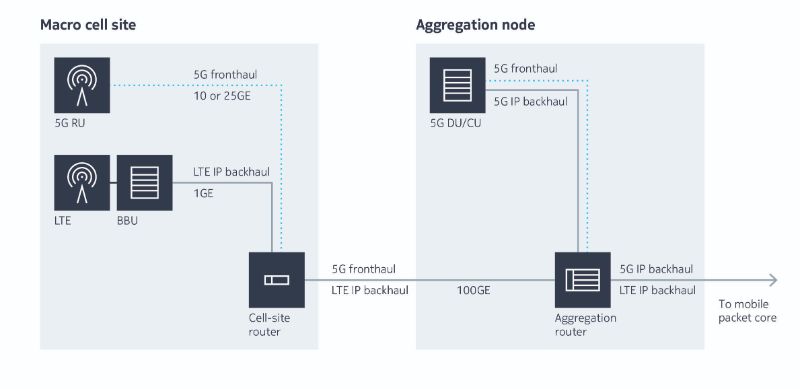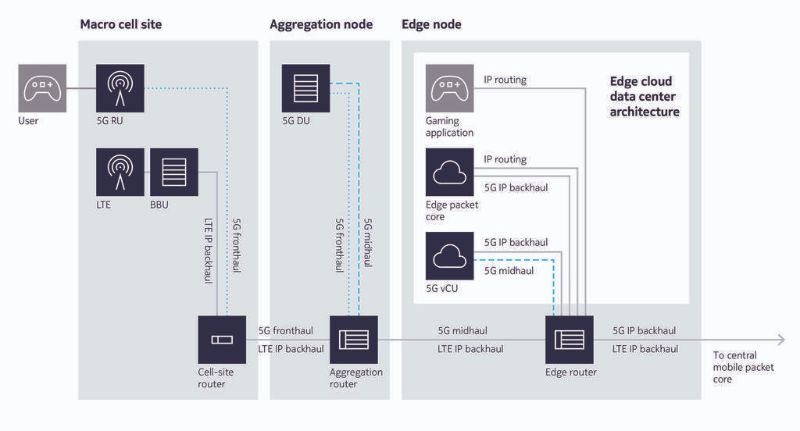Wireless and cloud innovations drive mobile transport evolution.
Evolving mobile transport infrastructures is critical to remain in lockstep with a changing industry, extending the benefits of the cloud and 5G while continuing to support 4G and 3G networks. Looking at the transport network in light of changes to RAN and cloud architectures can enable mobile network operators (MNOs) to keep up with disruptions caused by shifting traffic patterns, and societal and economic changes.
Wireless networks are evolving: Centralized RAN (C-RAN) and edge cloud networking
The cost of rolling out 5G on a mass scale is driving MNOs to consider centralizing their 5G RAN baseband functionality in densely populated regions where the economics make sense. Centralization reduces CAPEX (as baseband equipment can be shared by multiple radios) and OPEX (with less equipment to maintain at cell sites).
The 3GPP has defined new RAN functional splits for 5G, giving MNOs more flexibility to place RAN functions where needed to meet constraints like performance, power, space, latency and cost. A commonly used functional split is into radio units (RUs), distributed units (DUs) and centralized units (CUs).
For now, although 5G RAN may be centralized in some locations, existing LTE decentralized RAN (D-RAN) systems will likely be left as they are to preserve existing investments. As a result, MNOs may choose to implement an LTE D-RAN + 5G C-RAN hybrid network (see Figure 1).
 Figure 1: LTE D-RAN + 5G C-RAN hybrid network
Figure 1: LTE D-RAN + 5G C-RAN hybrid network
To keep up with additional radio capacity, MNOs need to upgrade their mobile transport network to support growing bandwidth demands and enable RAN architecture changes.
As 5G traffic scales up, virtualized RAN (vRAN) and Open RAN (O-RAN) architectures will provide more flexibility and will be more economical than adding physical baseband units. Centralization provides a path to vRAN and O-RAN.
Cloud networking at the edge is another important development. MNOs need to support applications closer to users to improve user experience and to reduce the amount of traffic being carried across their networks. To do this, MNOs can set up edge cloud architectures at their aggregation or edge sites (see Figure 2) to support user applications and virtual RAN and mobile packet core functions.
In Figure 2, the transmission from a gaming user is received by the 5G RU at the cell site, then transmitted to the 5G DU at the aggregation node. From there, the transmission moves to the edge node for processing by the virtual CU (vCU) and the edge packet core functions before being delivered to the gaming application’s compute functionality. IP routers provide the end-to-end connectivity between the physical and virtual mobile network functions and the gaming application.
 Figure 2: IP transport for edge cloud architecture
Figure 2: IP transport for edge cloud architecture
Considerations for the IP transport network
Simultaneous support for RAN technologies, RAN evolution and edge cloud connectivity are putting new requirements on IP transport networks in addition to the need for higher bandwidth. For C-RAN architectures, there are two key considerations.
Latency
The maximum tolerable one-way latency for RAN signals between the RU and DU is very small at 100µs.
The greatest source of latency is the time it takes for light to travel over fiber, limiting the distance between the RU and DU. Another contributor is the nodal delay time for packets to be received, processed and retransmitted by each router in the path. Nodal delay times for the current generation of routers are under 5 μs. Older generations of routers have nodal latency of 10-20 μs.
For fronthaul applications, MNOs need to consider the total nodal latency of all the IP transport platforms in the path between the RU and DU to ensure it will be within the latency budget. This is especially pertinent when cell sites are connected in ring rather than in point-to-point configurations.
MNOs can also use router quality of service features to ensure that fronthaul traffic is prioritized over backhaul or enterprise traffic and avoid queuing delays in the routers.
Synchronization and network timing
Synchronization is essential for mobile network operation and enabling radio functions such as handovers and carrier aggregation to work properly.
In 5G there will be many more radio locations, including small cells. Having a Global Navigation Satellite System (GNSS) receiver at each cell site to provide a timing source would be cost prohibitive, so MNOs will need to have GNSS-based primary reference timing clocks distributed in their network, then use the IEEE 1588v2 Precision Time Protocol (PTP) over the IP routing network to distribute timing to RAN elements. Synchronous Ethernet (SyncE) and PTP are used together for higher accuracy.
Routers used in fronthaul applications must comply to new specifications for greater timing accuracy including ITU-T G.8262.1 for SyncE and ITU-T G.8273.2 Class C for PTP to satisfy RAN synchronization requirements. Using routers with built-in GNSS receivers and PTP grand master capability saves the expense of provisioning additional grand-master timing devices in the network.
Supporting the race to 5G
Mobile service providers are racing to offer enhanced mobile broadband services to customers and have them upgrade to 5G devices. Enterprises and public sector entities are embracing digital transformation based on intelligent sensors and networked equipment, driving demand for 5G-based IoT services. As new services are adopted, end users and their applications will demand increasing amounts of bandwidth and options such as low latency.
A C-RAN architecture combined with edge cloud networking allows MNOs to share assets while offering an enhanced 5G experience to their end customers. Centralization also provides CAPEX and OPEX savings and provides a path to vRAN and future O-RAN architectures.
To keep up with the additional radio capacity, MNOs need to upgrade their mobile transport networks to support growing bandwidth demands and enable these RAN architecture changes. Latency and synchronization are important considerations that must be addressed in the IP transport network.
In the end, implementation options are varied, and one size does not fit all. A well-designed transport network will be key to the successful rollout of new 5G services and customer retention in a competitive marketplace.




















